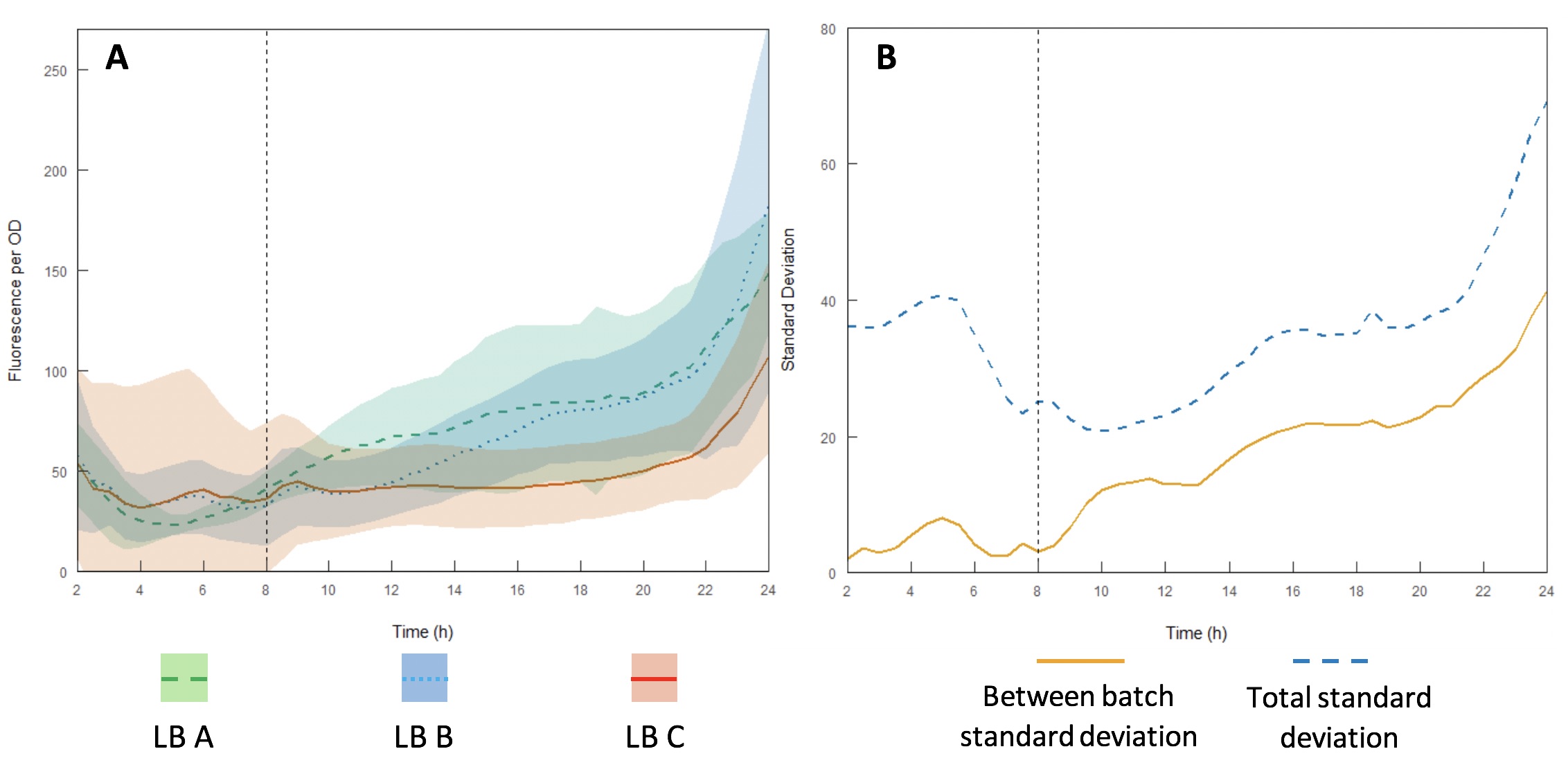| Line 191: | Line 191: | ||
<figure> | <figure> | ||
<img src="https://static.igem.org/mediawiki/2018/0/0e/T--Newcastle--Internal_Standards.png" alt="RFP Plasmid" style="width:80%"> | <img src="https://static.igem.org/mediawiki/2018/0/0e/T--Newcastle--Internal_Standards.png" alt="RFP Plasmid" style="width:80%"> | ||
| − | < | + | </figure> |
| − | + | <p><center><b>Figure 2. A) Scatter plots showing the relationship between Relative AFUs (GFPmut3b fluorescein/OD) against time (x-axis) for the original test device and the internal standard test devices & B)Scatter plots showing the relationship between Relative AFUs (RFP fluorescence/OD) (y-axis) and time (x-axis) for the RFP internal standard test devices.</b> A)The legend for each device is shown on the left of each graph. Over 24 hours, the original test devices reach peak fluorescence at around the 6-7 hour mark, with devices 4 & 1 being the strongest and 3 & 6 being the weakest. After the 6 hour mark there is a decrease in fluorescence to the 22 hour mark where fluorescence beings to increase once again. The internal standard devices all showed a consistent increase with no decrease over 24 hours. Device 2 was the most fluorescent with devices 1 and 4 being significantly lower than the original group. Fluorescence was lower for each device initially than the original but eventually surpassed the original study as the fluorescence decreased over time. | |
| − | </ | + | B> Over the 24 period, the control groups and devices 1 & 4 exhibited a fluorescence/OD of 0. The remaining other devices - 2, 3 & 6 – all showed a consistent positive increase in fluorescence/OD. Device 2 however has the highest fluorescence/OD throughout the study, followed by devices 6, 3 and 2 with fluorescence/OD values of 0.064, 0.048 and 0.038 respectively. These groups began fluorescing between 200 and 440 min.</p> |
| + | |||
| Line 226: | Line 227: | ||
<figure> | <figure> | ||
<img src="https://static.igem.org/mediawiki/2018/f/f3/T--Newcastle--mNeon.png" style="width:80%"> | <img src="https://static.igem.org/mediawiki/2018/f/f3/T--Newcastle--mNeon.png" style="width:80%"> | ||
| − | < | + | </figure> |
| − | </ | + | <p><center><b> Figure 3. A) UV imaging of LB+cam agar streak plates containing E. coli transformed with respective pSB1C3 mNeonGreen vectors. B)Box and whisker plot of the fluorescein/OD (y-axis) values against time (x-axis) for the original and mNeonGreen test devices in the InterLab study at 0 hours and 6 hours.</b> A) Each vector held the mNeonGreen gene, inserted via Gibson Assembly. The figure shows, in order, colonies from test device 1 (Top Left) through to test device 4 (bottom right). Devices 1, 2, and 4 yield the brightest colonies, with device 4 beginning to show a yellow/green colour in comparison to the others which are predominantly green. Device 3 is the weakest promoter of the group and its colonies show little fluorescence. B)The legend for each device is shown at the bottom of the graph. Throughout the tests, for both replicate colonies the sample groups deviated from normality. Kruskal-Wallis testing was performed and revealed a significant difference in median between the device groups (p < 0.001). Post-hoc Dunn testing for each of the colonies and time points revealed that there were no significant differences in median fluorescein/OD of the original vectors and their mNeonGreen counterparts of the same device group At hour 0, throughout the GFP and mNeonGreen devices there are large spreads of data. At hour 6, mNeonGreen devices can be seen to have a smaller spread of data when compared to GFP in both colonies 1 & 2. Also, in most cases, the fluorescence is much higher in the mNeonGreen, with mNeonGreen TD4 having the highest median fluorescein/OD value (1.57) of the whole study. The pattern of fluorescence regarding the most productive devices is the same as that of the original InterLab study.</p> |
<p> The data indicate that mNeonGreen was not significantly brighter than mut3GFP as was proposed. Figure 4 shows that the fluorescence patterns in mNeonGreen are similar to those of the original test devices, with 4 & 1 being the strongest promoters and 3 being the weakest. However, the values for both replicate colonies show that the spread of fluorescence/OD600nm values for the mNeonGreen reporter is lower in each test device group. </p> | <p> The data indicate that mNeonGreen was not significantly brighter than mut3GFP as was proposed. Figure 4 shows that the fluorescence patterns in mNeonGreen are similar to those of the original test devices, with 4 & 1 being the strongest promoters and 3 being the weakest. However, the values for both replicate colonies show that the spread of fluorescence/OD600nm values for the mNeonGreen reporter is lower in each test device group. </p> | ||
Revision as of 11:35, 17 October 2018















